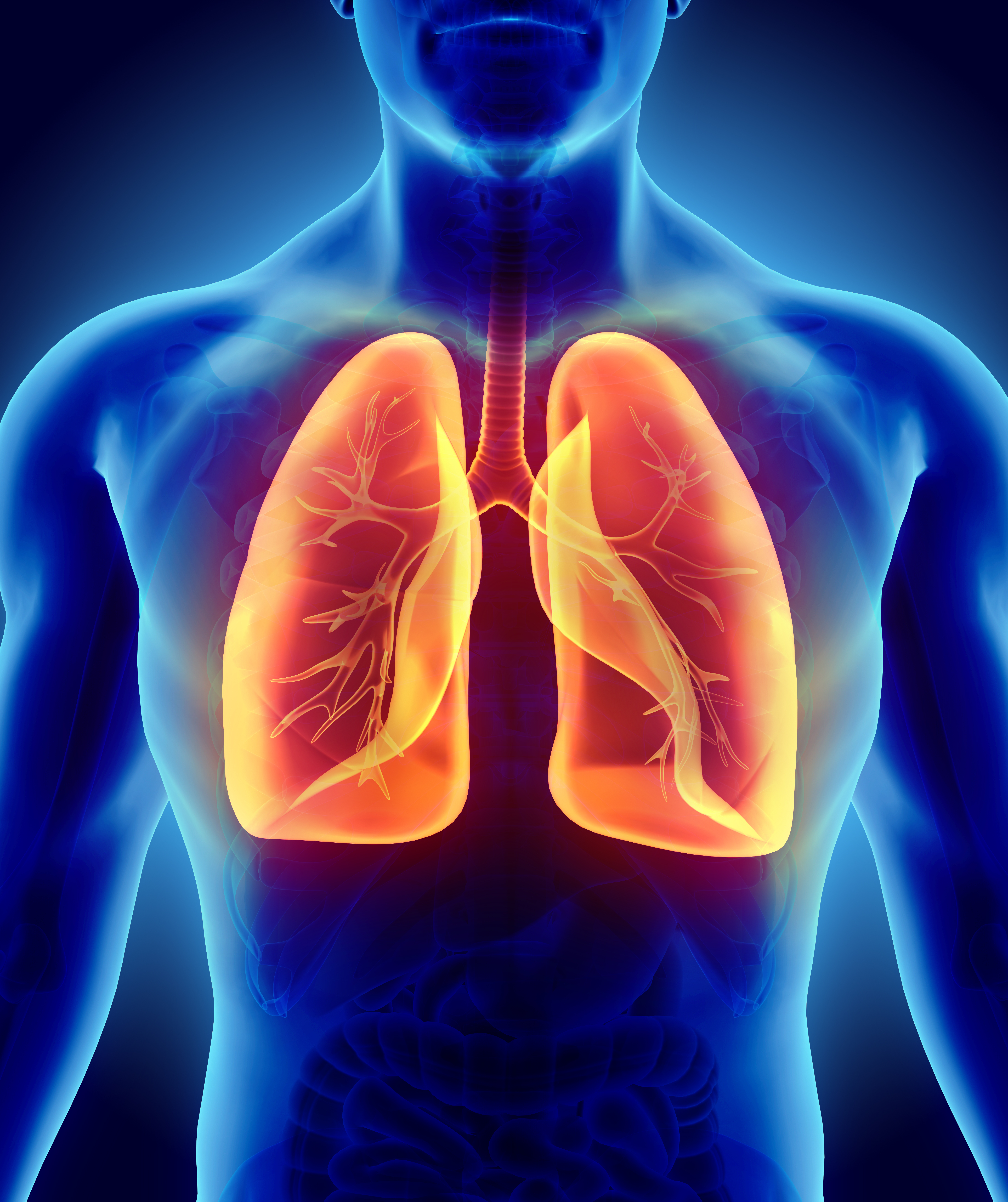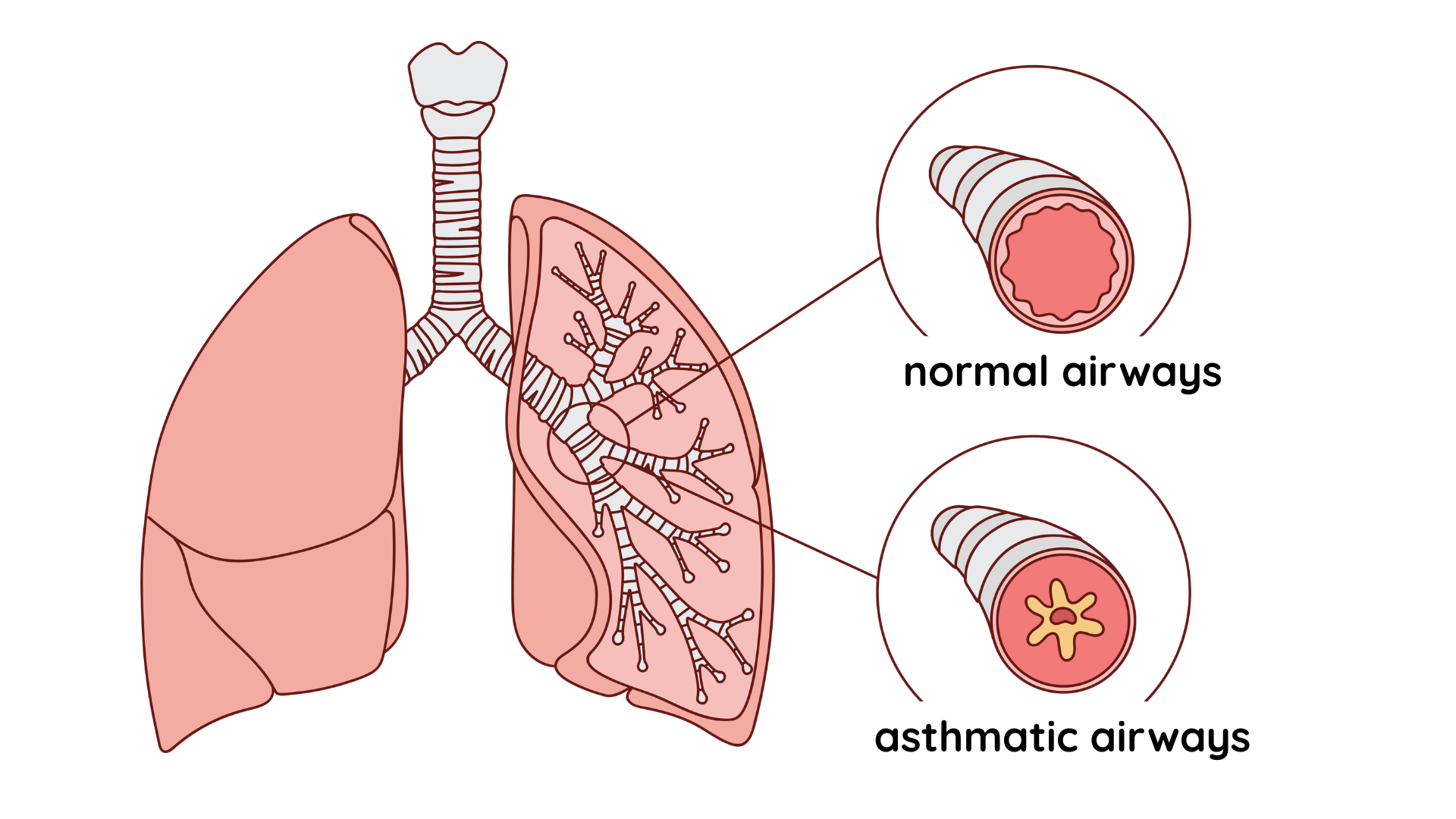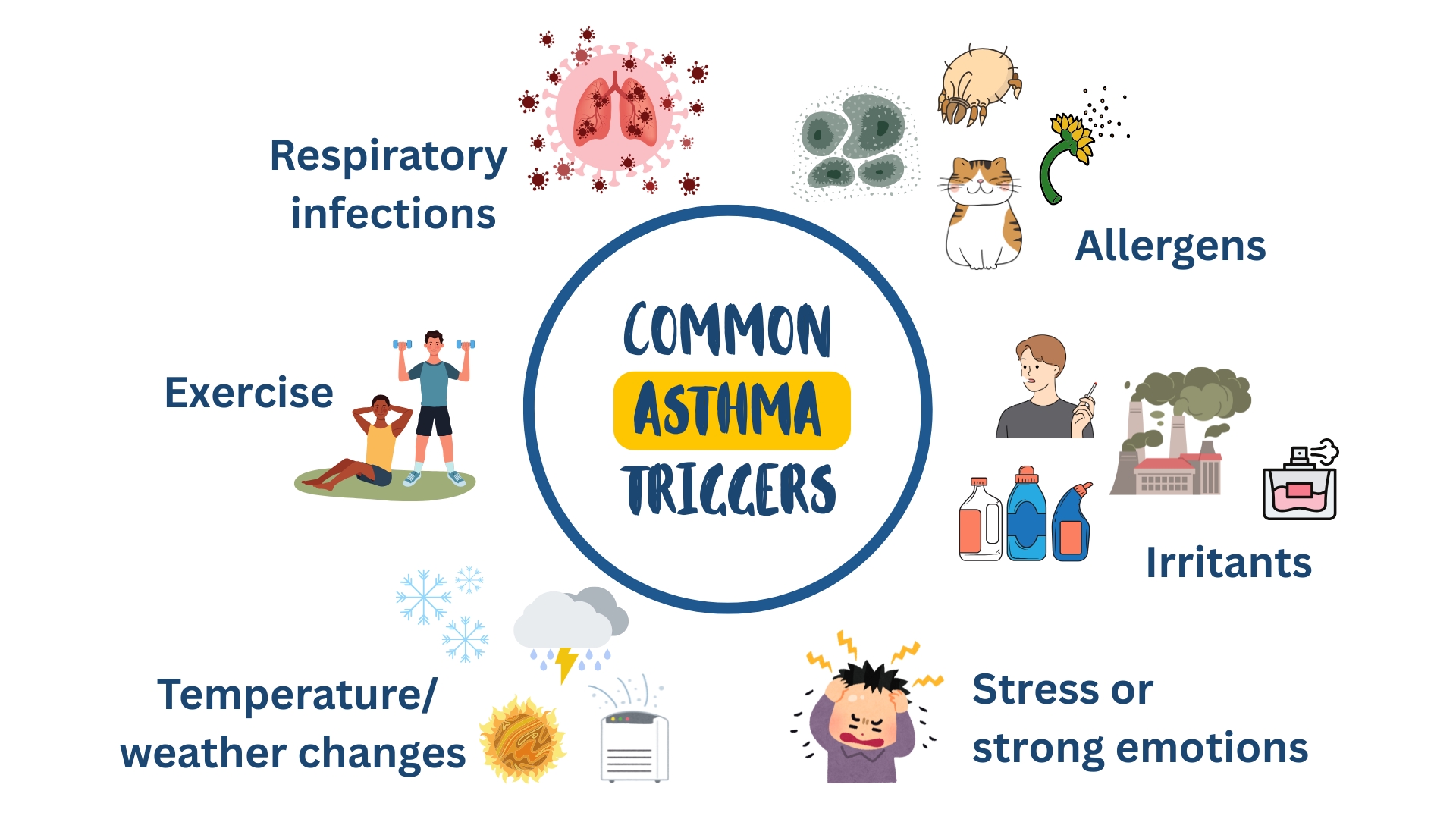Your airways start at the entrance of your nostrils and go down to tiny sacs in your lungs called alveoli, via a series of tubes, like an upside-down tree. The main job of your airways is to bring oxygen into the body and remove carbon dioxide, a waste gas. They also help protect your lungs from harmful particles like dust and germs, regulate the temperature and moisture of the air you breathe, and work with other parts of the body to support speech and smell.

It is important to keep your airways healthy. This includes avoiding exposure to smoke, chemicals, and other substances that can irritate or damage them.
Asthma is a long-term (chronic) condition that affects the lower airways - the breathing tubes in your lungs. It is a common condition, impacting over 250 million people worldwide, and contributing to more than 450,000 deaths each year. This disease causes three main changes in the airways:
Inflammation: The inner lining of the airways becomes red and swollen, making the space for air to pass through narrower.
Muscle tightening: The muscles around the airways tighten, which further narrows the airways.
Excess mucus: The irritation causes the airways to produce extra mucus, which can clog the already narrowed space.
These changes make it harder to breathe, especially when breathing out.

People with asthma can get symptoms like wheezing, breathlessness, a cough or a tight chest. Sometimes symptoms can get worse quickly. This is an asthma attack, also known as an asthma flare-up or asthma exacerbation.
Unfortunately, it can’t be cured yet; it is considered a lifelong condition. The good news is that with the right treatment, most people can keep their asthma well-controlled and enjoy a normal, active life.
With new treatment options emerging, the medical field is shifting its focus toward a new goal: asthma remission. A state in which symptoms are minimal or even completely absent for an extended period. The medical community is optimistic that achieving remission will become possible for more patients in the future.
Even if you feel well and have few or no symptoms, it’s important to keep taking your medication as prescribed. That’s because the underlying inflammation in your airways is still there — even when you're not feeling it. Asthma flare-ups can still happen, especially if you're exposed to common triggers like a cold or flu, air pollution, or certain substances at work.
The exact cause of asthma isn’t fully known, but it’s believed to develop through a combination of your inherited (genetic) factors and things you’re exposed to in your environment.

Family history:
You're more likely to get asthma if asthma or other allergic conditions like eczema or hay fever run in your family. If you have a parent with asthma, you are three to six times more likely to develop it than someone who does not.
Exposure to irritants:
Exposure to cigarette smoke, living in areas with high air pollution, or exposure to certain substances in the workplace, such as dust, fumes, or chemicals, increases your risk of developing asthma.
Illness during childhood:
Some types of airway infections at a very young age increase the risk of developing asthma. Airway infections, mainly those caused by viruses, are also strongly linked to asthma flare-ups in children.
Additionally, studies have shown that children born preterm (fewer than 37 weeks of pregnancy) are at an increased risk of developing asthma.
Obesity:
It’s not fully known why obesity increases asthma risk. It might be due to the extra weight constricting the lungs, making it more difficult to breathe. Fat tissue also produces substances promoting inflammation, which might also affect the airways. What we do know is that people who have a higher weight often use more medications, suffer worse symptoms and are less able to control their asthma than patients in a healthy weight range.
Allergic diseases:
If you have an allergic condition, such as atopic dermatitis (eczema) or hay fever, you are at a higher risk of developing asthma as well.
Asthma symptoms are variable over time. These symptoms, which can range from mild to severe, often start after exposure to a specific trigger. Everyone’s asthma is different — what triggers symptoms in one person might not affect someone else.

The following are common asthma triggers:
* Exercise can trigger asthma in some people. However, all people with asthma are encouraged to stay active and live a healthy lifestyle. Regular physical activity promotes lung health and may also support weight control — both of which are important for managing asthma. Exercising has been shown to improve lung function. If exercise triggers your asthma, your doctor might recommend using an inhaler before you start and keeping one with you while you exercise.
Asthma is a common condition, affecting over 250 million people worldwide. Your healthcare provider might use different terms to describe your asthma. You might have different types of asthma at the same time. Important types of asthma are:
Allergic asthma is a type of asthma triggered by allergens like pollen, pet dander, or dust mites. About 4 in 5 people with asthma also have allergies. However, having allergic asthma doesn’t mean you won’t react to non-allergic triggers. Many people with allergic asthma also report symptoms triggered by things like cigarette smoke or weather changes.
A form of asthma that isn’t related to allergic triggers. About 1 in 5 patients with asthma have non-allergic asthma. This type of asthma tends to develop later in life. Non-allergic asthma can be triggered by irritants, such as cigarette smoke or air pollution, respiratory infections, aspirin and NSAID painkillers and stress.
Approximately 1 in 7 people with adult-onset asthma develop the condition due to exposure in the workplace. Work-related asthma is divided into two subtypes: occupational asthma and work-aggravated asthma. Occupational asthma is asthma that is caused by inhaling substances at the workplace, like fumes, dust or chemicals. Workers at higher risk of developing occupational asthma include bakers, healthcare workers, and animal handlers. This type of asthma may be reversible if the exposure that triggers the asthma is identified early and avoided. Work-aggravated asthma is asthma that is not caused by irritants specific to the workplace, but is pre-existing asthma that is worsened by asthma triggers at work
Narrowing of the airways during physical activity—known as exercise-induced bronchoconstriction—affects around 1 in 5 people in the general population. It's much more common in people with asthma, with around 9 out of 10 experiencing it. It’s also frequently seen in elite athletes, where as many as 3 to 7 out of 10 may be affected.
Even if exercise triggers your symptoms, the good news is that—with the right treatment—you can stay active. Your doctor can recommend steps to help prevent symptoms before physical activity, so you can keep doing the things you enjoy.
Eosinophilic asthma is a type of asthma associated with high levels of white blood cells, called eosinophils, in the airways. It often starts in adulthood and may not respond well to standard asthma treatments. You can have eosinophilic asthma as part of another type of asthma. For example, some people have allergic eosinophilic asthma or severe eosinophilic asthma.
Some people with asthma, nasal polyps, and reactions to aspirin or NSAIDs (non-steroidal anti-inflammatory drugs) have a condition called aspirin-exacerbated respiratory disease (AERD or N-ERD). It affects roughly 1 out of 10 adults with asthma and as many as 1 in 3 among those who also have nasal polyps. While aspirin or other NSAIDs don’t cause N-ERD, they can trigger or worsen symptoms. The exact cause isn’t known, but it doesn’t seem to run in families.
Irrespective of the underlying asthma type, some people continue to have troublesome symptoms even when they’re using high doses of asthma medication correctly. This is known as severe asthma. Patients with severe asthma should be referred to an asthma specialist, and treatment may involve even more specialised therapies, such as biologics, or procedures like bronchial thermoplasty (see chapter on Treatment). People who often experience flare-ups or regularly need oral steroids to control their symptoms may be eligible for these more personalised treatment options.
This website does not provide medical advice.
The information, including but not limited to text, graphics, images, and other material contained on this website, is for informational purposes only. No material on this site is intended to be a substitute for professional medical advice, diagnosis, or treatment and/or medical treatment by a qualified physician or healthcare provider. EUFOREA is not a medical organisation and cannot provide specific medical advice to patients via the Internet and/or Email. All patients are encouraged to direct their specific questions to their personal physicians. EUFOREA presents this information to patients so that patients can understand and participate in their own medical care. EUFOREA strongly emphasises that the information contained on this website is not a substitute for thorough evaluation and treatment by a qualified healthcare provider.
© 2025 - EUFOREA - All rights reserved. All content on this portal, such as text, graphics, logos and images, is the property of EUFOREA. They may not be reproduced, copied, published, stored, modified or used in any form, online or offline, without prior written permission of EUFOREA.